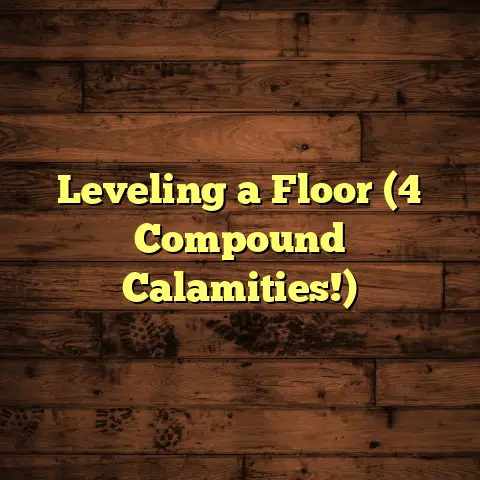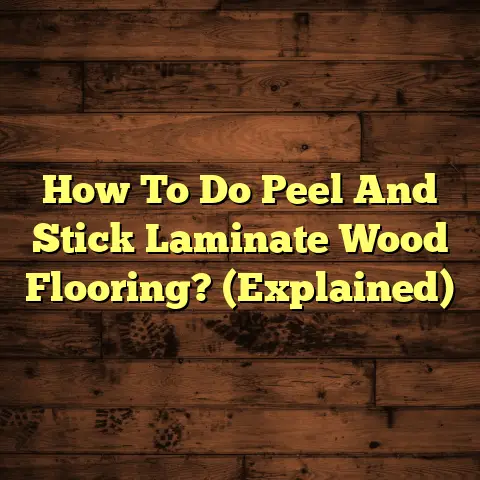Do Hardwood Floors Need to Breathe? (1 Mistake Kills!)
It sounds harmless, right?
But believing this can lead to a major mistake that can absolutely devastate your beautiful floors.
Let’s dive into the truth about hardwood, separate fact from fiction, and I’ll reveal the one deadly mistake you need to avoid.
Section 1: Expert Picks on Hardwood Flooring
Before we get into the nitty-gritty, let’s talk about what the pros are saying.
I’ve consulted with other contractors, read countless industry publications, and followed some of the top home improvement influencers.
The consensus is clear: proper installation and consistent maintenance are key.
“Hardwood flooring is an investment.
Protect that investment with proper acclimation and consistent humidity control.” – Bob Vila, Home Improvement Expert
What are the experts recommending?
Solid Hardwood: For timeless beauty and longevity, many still prefer solid hardwood.
Oak (red and white) remains a classic choice due to its durability and availability.
Maple and Hickory are also popular for their hardness.Engineered Hardwood: Engineered hardwood is gaining traction because of its stability.
It handles moisture fluctuations better than solid wood, making it suitable for basements and humid climates.Finishes: Polyurethane finishes are still widely used for their durability and water resistance.
However, many are now opting for penetrating oil finishes for a more natural look and easier spot repairs.-
Trusted Brands: Some brands that consistently get high marks from professionals include:
-
Bruce: Known for their wide selection and affordability.
-
Armstrong: A long-standing brand with a reputation for quality.
-
Somerset: Highly regarded for their Appalachian-sourced hardwood.
-
Now, how does all this relate to our “breathing” myth?
Well, experts emphasize proper acclimation before installation.
This is where the idea of “breathing” gets twisted.
Acclimation is crucial, but it’s not about letting the floor breathe after it’s installed.
Section 2: Understanding Hardwood Floors
Let’s break down what hardwood flooring actually is.
Solid vs. Engineered:
Solid Hardwood: Made from a single piece of wood.
It’s durable, can be refinished multiple times, and adds value to your home.
However, it’s susceptible to expansion and contraction with changes in humidity.Engineered Hardwood: Constructed from multiple layers of wood veneer bonded together.
The core layers are often made of plywood or high-density fiberboard (HDF).
It’s more dimensionally stable than solid wood and less prone to warping.
The Natural Properties of Wood:
Wood is a hygroscopic material.
This means it naturally absorbs and releases moisture from the surrounding air.
This is why humidity control is so important.
Expansion and Contraction:
When humidity increases, wood absorbs moisture and expands.
When humidity decreases, wood releases moisture and contracts.
This is a natural process, but excessive expansion and contraction can lead to problems like:
- Gaps between boards
- Cupping (where the edges of the boards are higher than the center)
- Crowning (where the center of the boards is higher than the edges)
- Buckling (where the floor lifts off the subfloor)
Section 3: The Breathing Myth
So, let’s tackle this myth head-on. Do hardwood floors really need to breathe?
The short answer is no.
Where Did This Myth Come From?
I believe the “breathing” myth likely originated from a few factors:
Old Construction Practices: In older homes, building practices were different.
Homes weren’t as tightly sealed, and natural ventilation was more common.
People may have associated this with healthy wood floors.Misunderstanding of Acclimation: As mentioned earlier, acclimation is crucial.
But people often confuse acclimation with ongoing ventilation.
Acclimation is about allowing the wood to adjust to the average humidity levels of the home before installation.-
Anecdotal Evidence: People might say, “My grandma always left the windows open, and her floors were fine!” But that’s anecdotal and doesn’t account for other factors like the type of wood, the climate, and the quality of the installation.
Harmful Practices:
Here are some common practices that homeowners believe help their floors “breathe,” but can actually be harmful:
Leaving Large Gaps: Intentionally leaving large gaps between boards is a terrible idea.
It allows debris to accumulate, creates tripping hazards, and doesn’t effectively control expansion and contraction.-
Excessive Ventilation: Constantly opening windows or running fans in an attempt to “air out” the floors can lead to rapid humidity fluctuations, which can be more damaging than stable, slightly elevated humidity.
-
Ignoring Humidity Control: This is the biggest mistake of all, which we will discuss next.
Section 4: The One Mistake That Can Kill Your Hardwood Floors
Here it is, folks, the single biggest mistake that can absolutely destroy your hardwood floors:
Neglecting Humidity Control
I can’t stress this enough.
Maintaining a consistent humidity level in your home is the most important thing you can do to protect your hardwood floors.
Why is Humidity Control So Critical?
As we discussed, wood is hygroscopic.
When humidity levels fluctuate wildly, your floors will expand and contract excessively.
This leads to all sorts of problems, including:
- Gapping: Noticeable gaps will appear between the boards, especially during the dry winter months.
- Cupping/Crowning: The boards will warp, creating an uneven surface.
- Buckling: In severe cases, the floor can lift entirely off the subfloor.
- Finish Damage: Excessive movement can stress the finish, leading to cracks and peeling.
The Ideal Humidity Range:
Generally, you want to maintain a relative humidity level between 35% and 55%.
This range allows the wood to maintain a stable moisture content, minimizing expansion and contraction.
Real-Life Examples:
I’ve seen this mistake firsthand countless times.
Case Study 1: I was called to a home where the hardwood floors were severely cupped.
The homeowner had intentionally turned off their humidifier during the winter to save money on their energy bill.
The result?
Thousands of dollars in damage and a complete floor replacement.Case Study 2: Another client had beautiful, newly installed hardwood floors that started buckling within a few months.
They lived in a humid climate and didn’t have a dehumidifier.
The excess moisture caused the floors to expand and push against the walls, leading to buckling.
“I had to replace my entire living room floor because I didn’t realize how important humidity control was.
It was an expensive lesson to learn!” – Sarah J., Homeowner
These are just a few examples of how neglecting humidity control can wreak havoc on your hardwood floors.
Section 5: Proper Maintenance Techniques
Now that we know what not to do, let’s talk about how to properly maintain your hardwood floors.
Humidity Control:
- Invest in a Humidifier/Dehumidifier: Depending on your climate, you may need both.
A whole-house humidifier is ideal for dry climates, while a dehumidifier is essential for humid climates. - Monitor Humidity Levels: Use a hygrometer to track the humidity in your home.
Adjust your humidifier/dehumidifier as needed to maintain the ideal range.
Cleaning Methods:
- Regular Sweeping/Vacuuming: Remove dirt and debris regularly to prevent scratches.
- Damp Mopping: Use a microfiber mop and a pH-neutral hardwood floor cleaner.
Avoid using excessive water, as it can seep into the seams and damage the wood.
Never use steam mops, as they can force moisture into the floor.
Protective Measures:
- Rugs: Place rugs in high-traffic areas to protect the finish from wear and tear.
- Furniture Pads: Use felt pads under furniture legs to prevent scratches.
- Doormats: Place doormats at entrances to trap dirt and moisture.
Step-by-Step Guide:
-
Monitor Humidity: Check your hygrometer regularly and adjust your humidifier/dehumidifier as needed.
-
Sweep/Vacuum: Sweep or vacuum your floors at least once a week.
-
Damp Mop: Damp mop your floors every 1-2 weeks, using a pH-neutral cleaner and a microfiber mop.
-
Spot Clean: Clean up spills immediately to prevent staining.
-
Protect: Use rugs, furniture pads, and doormats to protect your floors from wear and tear.
By following these simple steps, you can keep your hardwood floors looking beautiful for years to come.
Section 6: Expert Recommendations for Avoiding Damage
Let’s wrap up with some final expert recommendations to help you avoid that deadly mistake and ensure the longevity of your hardwood floors.
Professional Installation: Hire a qualified flooring contractor for installation.
Proper installation is crucial for preventing problems down the road.-
Acclimation: Allow the wood to acclimate to your home’s environment for several days before installation.
Regular Inspections: Inspect your floors regularly for signs of damage, such as gaps, cupping, or buckling.
Address any issues promptly.Climate Considerations: Choose the right type of hardwood for your climate.
Engineered hardwood is a better choice for humid climates, while solid hardwood may be suitable for drier climates.Environment: Consider the location of your floors.
Avoid installing hardwood in areas that are prone to moisture, such as bathrooms or laundry rooms.Consult a Professional: If you’re unsure about anything, consult a flooring specialist.
They can provide personalized advice based on your specific situation.
Additional Tips:
-
Avoid Extreme Temperature Changes: Avoid drastic temperature changes in your home, as they can affect humidity levels.
-
Ventilate Properly: Ensure proper ventilation in your home to prevent moisture buildup.
-
Be Mindful of Pets: Trim your pets’ nails regularly to prevent scratches.
Conclusion
So, do hardwood floors need to breathe?
Absolutely not in the way most people think.
The key takeaway is that humidity control is paramount.
By maintaining a consistent humidity level in your home and following proper maintenance techniques, you can protect your hardwood floors from damage and enjoy their beauty for years to come.
Don’t fall victim to the “breathing” myth.
Instead, focus on creating a stable environment for your floors and following the advice of flooring professionals.
Your floors (and your wallet) will thank you!





